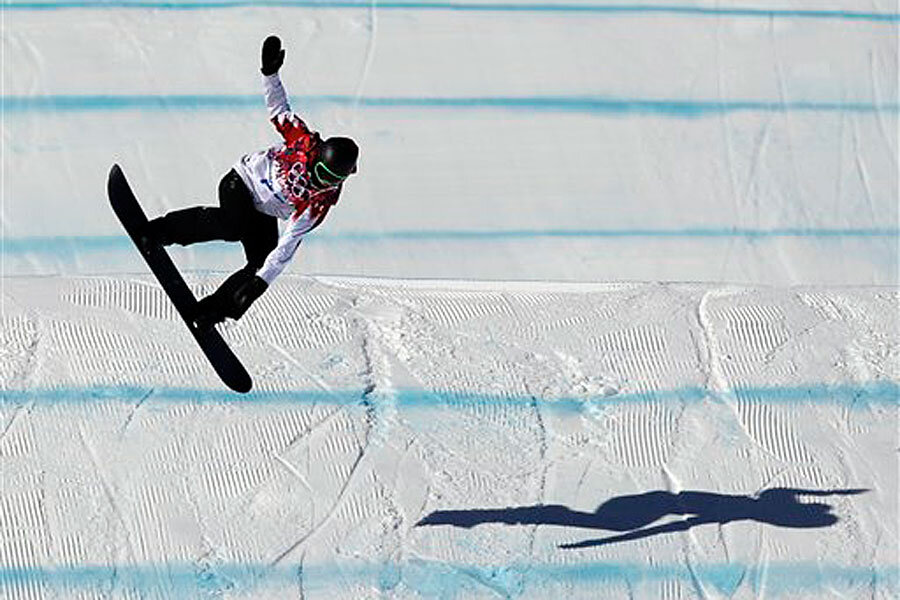Sochi slopestyle snowboarding debuts: Who needs Shaun White?
| Krasnaya Polyana, Russia
And to think, Shaun White chose not to ride down this course.
Snowboarders kicked off competition at the Olympics on Thursday by making the slopestyle layout that White deemed "intimidating" feel anything but that.
Sunny skies. No wind. Decent snow. All in all, slopestyle's debut on the grand stage was a great day for riding rails and grabbing big air and an even better day for scores.
Canadian Max Parrot backed up his win last month at the Winter X Games with a 97.5 — 2½ points short of perfect — in a qualifying run punctuated by a triple-flipping jump with a dead-solid landing, the likes of which will be virtually mandatory to win the gold medal.
He was one of eight riders to reach the 90s on a day in which Australia's Scotty James and Norway's Kjersti Buaas took the worst falls, but both walked away.
"Other riders complained about the course this week. I actually found it really good from Day One to now," Parrot said.
White pulled out Wednesday, saying he wanted to focus on winning a third straight gold medal in the halfpipe next week. He was in no mind to put his health at risk on a course that took out one of the world's top riders, Torstein Horgmo of Norway, and sent dozens more tumbling in training.
Things still weren't 100 percent ideal when competition began, one day before the opening ceremony.
"It's getting better. Not fully perfect yet. Pretty icy. Makes it hard to shape the jumps clean," said Norway's Staale Sandbech, who scored 94.5.
Leading female contender, American Jamie Anderson, had no problem the day after banging up her back in practice. She called the course conditions "questionable," especially for the women.
"It's a challenging course. A lot of impact for everyone," Anderson said after a 93.5. "Little 15 year olds are, like, 'I'm not even old and my back is still sore every day. Not even from crashing, just from riding.'"
Among the problems they're dealing with are too-steep takeoff ramps that don't exactly mesh with the pitch of the landings. The transition areas between the jumps aren't very big, so it's hard to build up the speed needed to get the air the steepest jumps demand.
But the course builders are adjusting and, overall, the riders responded well.
It made White's absence that much more confounding to several of the 29 men left in the field, who complained that, among other things, his last-minute decision cost someone a spot on the U.S. team.
"It would've been so awesome to have him in here today," American Sage Kotsenburg said. "He could've put down a super sick run that could contend. But it's his choice."
Nobody is feeling White's absence more than Parrot, who is peaking at precisely the right time.
"I'm just mad about it because I want to compete against him," Parrot said. "I want to know who's better."
The improved conditions invited such high scores that at least one rider felt free to turn his attention to a more traditional sort of griping: Judging.
Canada's Mark McMorris, a favorite for the gold until he broke a rib at the X Games, landed a triple cork and put down a clean run that ended with him grabbing his sore back. He received only an 89.25.
"I did one of the only legitimate triple corks and didn't get rewarded for it, so it's too bad," he said.
But, in keeping with the sunshiny theme of the first Olympic sport to feature a gigantic Russian matryoshka doll in the middle of the course (And yes, riders can feel free to jump over it) McMorris will get a second chance. In fact, everybody will.
Conceding that it's bad form to end anyone's Olympics before they march in the opening ceremony, the format was tweaked slightly. The top four riders in each heat advanced directly to the weekend finals, with everyone else getting another shot at qualify during semifinals.
Friday is an off day where more work on the course is expected.
"Everything we've done here is completely normal," American Chas Guldemond said. "It's the second-best course of the year (next) to X Games. I'm happy with it."
Among the most critical of White's decision to withdraw was Canadian Sebastien Toutant, who tweeted, then deleted, a message saying White was essentially ducking the competition.
Toutant clarified things shortly after finishing third in the Heat 1.
"I'm not saying he wouldn't have any chance," Toutant said. "He's an amazing snowboarder. What I'm saying is, it's not fair. ... Whoever is going to win gold, some people are going to be, like, 'Oh, if Shaun was there, maybe he would have won.'"
No one will ever know, and the wisdom of White's decision will be hashed out next Tuesday in the halfpipe.
Until then, the forecast for slopestyle certainly feels much sunnier.
"It's not too big," said Australian Torah Bright, an early critic of the layout. "Everywhere we ride jumps, it's big. The problem was, we are the best of what we do and the course just wasn't up to par and the changes that were made definitely helped a lot."
___
Follow AP National Writer Eddie Pells on Twitter — http://twitter.com/epells
Copyright 2014 The Associated Press. All rights reserved. This material may not be published, broadcast, rewritten or redistributed.






